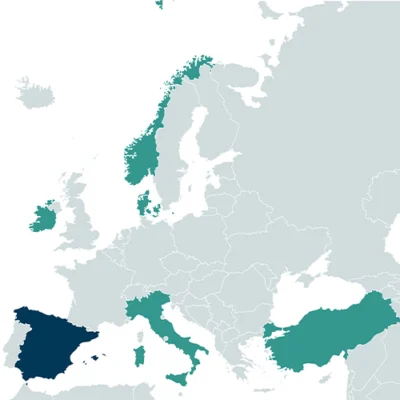Nature-based systems mission for aquatic biodiversity enhancement: Reducing pharmaceutical products pollution in urban and rural environments
Call
Duration
01/04/2025 – 31/03/2028
Total grant
Approx. 1.3 mil. €
More information
Gema Parra, gparra@ujaen.es
Partners of the project
- Center for Advanced Studies in Earth Sciences, Energy and Environment, University of Jaén, Spain
- Environment and Water Agency of Andalusia, Junta de Andalucía, Spain
- Department of Environmental Science, Aarhus University, Denmark
- Environment and Natural Resources, Hydrology and Water Environment, NIBIO, Norway
- School of Architecture, Planning and Environmental Policy, University of Dublin, Ireland
- Department of Agriculture, University Mediterranea of Reggio Calabria, Italy
- Environmental Engineering Department, Gebze Technical University, Turkey
- Killian Water APS, Denmark

Context
Pollution is a key driver affecting biodiversity loss. Part of the pollution comes from essential human activities, such as health care and food production through the use of pharmaceutical products (PP). Aquatic environments are quite vulnerable to PP pollution, both structure and functionality. Consequently, as traditional wastewater treatment plants (WWTP) cannot eliminate PP completely, and PP consumption increases steadily, there are resultant health threats to humans and ecosystems. However, some treatments are expensive and energy demanding. NbS, harnessing natural processes and ecosystems functioning, can help addressing the challenge our society is facing.
Main objectives
NBS4AQUAMISSION project focuses on the protection of aquatic biodiversity from pharmaceutical pollution through the use of NbS. The project is based on a triadic solution combining treatment wetlands, innovative materials, such as biochar and hydrochar, and bioaugmentation processes to enhance the NbS remediation capacity. The project will help to understand the effects of PP’s release on aquatic biodiversity. In addition, the assessment of NbS as efficient tools to reduce PP pollution, and environmental risks will substantially support informed decision-making on water management.
Main activities
NBS4AQUAMISSION will focus on 5 areas of activities:
- We will characterize PP pollution through state-of-the-art screening in urban and rural European demo sites;
- We will assess the aquatic biodiversity changes under PP pollution pressures through environmental DNA (eDNA) analysis;
- We will assess the effectiveness of the innovative NbS at pilot scale in PP pollution removal using chemical and ecotoxicological approaches;
- We will perform Life cycle, social and economic analysis of the NbS implementation;
- We will assess stakeholders’ profiles, attitudes and/or conflicts around NbS.
In summary, biodiversity enhancement driven by NbS implementation will recover ecosystem services, from provisioning (better water quality), to regulating (self-depuration in the aquatic ecosystems) and cultural services (“blue-green” areas enhancement for recreational proposes). The gathered social information will be translated into actionable items for water management and policy recommendations and the improved knowledge and innovation within the water resources sector will be able to help make savings in quaternary water treatment processes.